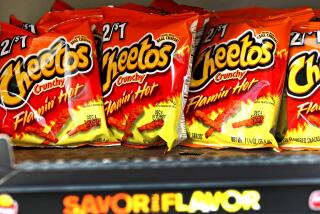Junk the Junk Food, Kill the TV
A statewide study released last month by the Public Health Institute found that a large number of California teenagers are at risk of chronic disease related to nutrition and weight as a result of poor eating habits and increasingly sedentary lifestyles. According to the survey of more than 1,200 teens, nearly a third of the youths polled were overweight and spent twice as much time watching TV as exercising. Only 2% of the teens met all the dietary and activity recommendations. MAURA E. MONTELLANO spoke with two women who work in the child nutrition field.
*
CHRISTIANE WERT
Program director, KidShape-UCLA
Today, many teens are experiencing very real physical consequences of poor eating and exercising habits. Being physically inactive and being overweight often lead to worsened asthma, high blood pressure, high blood cholesterol levels, the beginning of coronary artery disease and orthopedic disorders including hip displacements in children and teens. There also are numerous emotional effects.
Although genetics does play a role in a child’s weight, the environment needs to be there for those genes to be expressed. An environment in which poor eating habits are modeled by a teen’s parents and where high-fat and high-sugar foods are more readily available than low-fat, high-nutrient foods such as fruits and vegetables is an example of a negative environment. A lack of opportunity to be physically active is another cause. It might not be safe for some children to be out playing and being physically active in some neighborhoods.
Television creates all sorts of negative consequences. Some households cannot afford child care, so turning on the TV serves as a baby-sitter. Not only are they sitting still watching, but they’re also being bombarded with advertisements for high-fat and high-sugar foods.
In schools, healthier choices should be promoted and kids should be educated on what those choices are. Gym classes need to be increased, and the way they are taught should be improved so these kids will be turned on to physical activity and want to do it outside of school. Helping kids find resources for physical activity like parks and local YMCAs is important as well.
*
SUSAN J. BRONSTEIN
Coordinator of the health champions program, Santa Monica-Malibu Unified School District
Poor eating habits among teens range from indulging in high-fat, -sugar and -salt items to eating almost nothing. Results range from morbid obesity to anorexia nervosa and bulimia. This is devastating both emotionally and physically. Emotionally, a child who is overweight or obese can develop poor self-esteem and depression resulting in social isolation, drug abuse and eating disorders.
We rarely recommend dieting for a growing child but do suggest that children increase their fruit and vegetable consumption and their physical activity. Regular exercise improves mental, cardiovascular and musculoskeletal health. Teens can limit fat intake and increase exercise to improve their general health.
Vending machines in schools could offer dried and fresh fruit, vegetable snacks, low-fat dairy snacks and crackers.
This is a tough issue and has been discussed at length in our district. Our culture is too focused on ultra-thin, if not emaciated, images as reflected in the media. Extreme dieting can result in loss of menstrual periods, osteoporosis and even premature death. Low self-esteem, depression and loneliness are linked to poor eating habits.
Teens often feel invincible and don’t believe that the negative consequences of poor lifestyle habits will impact them.
My advice to parents is to keep healthy snacks available at home. Limit junk foods to special occasions. Set an example by exercising regularly. Spend some time outdoors as a family. Don’t forget to “turn off the TV.” Television viewing often is associated with snacking and may even contribute to the development of some eating disorders.
More to Read
Sign up for Essential California
The most important California stories and recommendations in your inbox every morning.
You may occasionally receive promotional content from the Los Angeles Times.










